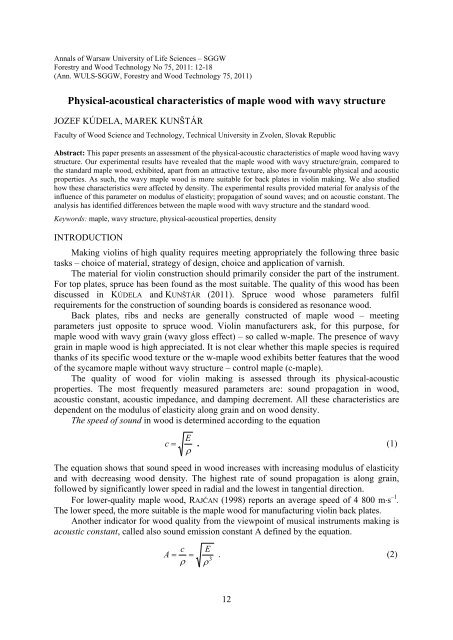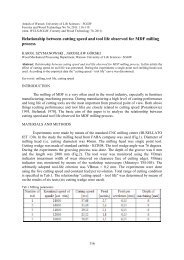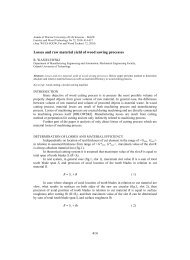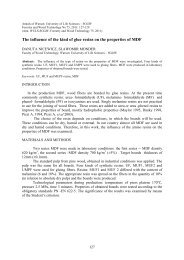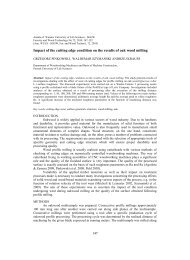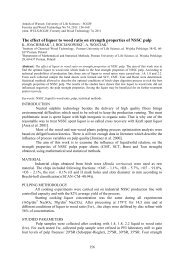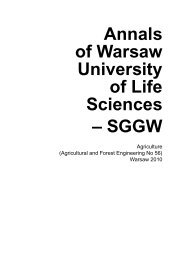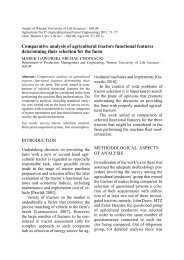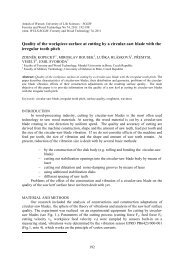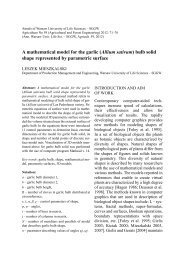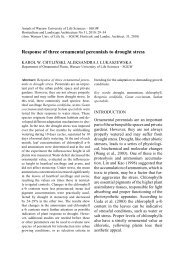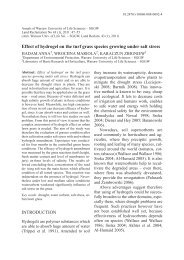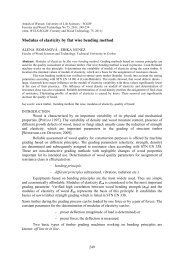Physical-acoustical characteristics of maple wood with wavy structure
Physical-acoustical characteristics of maple wood with wavy structure
Physical-acoustical characteristics of maple wood with wavy structure
You also want an ePaper? Increase the reach of your titles
YUMPU automatically turns print PDFs into web optimized ePapers that Google loves.
Annals <strong>of</strong> Warsaw University <strong>of</strong> Life Sciences – SGGW<br />
Forestry and Wood Technology No 75, 2011: 12-18<br />
(Ann. WULS-SGGW, Forestry and Wood Technology 75, 2011)<br />
<strong>Physical</strong>-<strong>acoustical</strong> <strong>characteristics</strong> <strong>of</strong> <strong>maple</strong> <strong>wood</strong> <strong>with</strong> <strong>wavy</strong> <strong>structure</strong><br />
JOZEF KÚDELA, MAREK KUNŠTÁR<br />
Faculty <strong>of</strong> Wood Science and Technology, Technical University in Zvolen, Slovak Republic<br />
Abstract: This paper presents an assessment <strong>of</strong> the physical-acoustic <strong>characteristics</strong> <strong>of</strong> <strong>maple</strong> <strong>wood</strong> having <strong>wavy</strong><br />
<strong>structure</strong>. Our experimental results have revealed that the <strong>maple</strong> <strong>wood</strong> <strong>with</strong> <strong>wavy</strong> <strong>structure</strong>/grain, compared to<br />
the standard <strong>maple</strong> <strong>wood</strong>, exhibited, apart from an attractive texture, also more favourable physical and acoustic<br />
properties. As such, the <strong>wavy</strong> <strong>maple</strong> <strong>wood</strong> is more suitable for back plates in violin making. We also studied<br />
how these <strong>characteristics</strong> were affected by density. The experimental results provided material for analysis <strong>of</strong> the<br />
influence <strong>of</strong> this parameter on modulus <strong>of</strong> elasticity; propagation <strong>of</strong> sound waves; and on acoustic constant. The<br />
analysis has identified differences between the <strong>maple</strong> <strong>wood</strong> <strong>with</strong> <strong>wavy</strong> <strong>structure</strong> and the standard <strong>wood</strong>.<br />
Keywords: <strong>maple</strong>, <strong>wavy</strong> <strong>structure</strong>, physical-<strong>acoustical</strong> properties, density<br />
INTRODUCTION<br />
Making violins <strong>of</strong> high quality requires meeting appropriately the following three basic<br />
tasks – choice <strong>of</strong> material, strategy <strong>of</strong> design, choice and application <strong>of</strong> varnish.<br />
The material for violin construction should primarily consider the part <strong>of</strong> the instrument.<br />
For top plates, spruce has been found as the most suitable. The quality <strong>of</strong> this <strong>wood</strong> has been<br />
discussed in KÚDELA and KUNŠTÁR (2011). Spruce <strong>wood</strong> whose parameters fulfil<br />
requirements for the construction <strong>of</strong> sounding boards is considered as resonance <strong>wood</strong>.<br />
Back plates, ribs and necks are generally constructed <strong>of</strong> <strong>maple</strong> <strong>wood</strong> – meeting<br />
parameters just opposite to spruce <strong>wood</strong>. Violin manufacturers ask, for this purpose, for<br />
<strong>maple</strong> <strong>wood</strong> <strong>with</strong> <strong>wavy</strong> grain (<strong>wavy</strong> gloss effect) – so called w-<strong>maple</strong>. The presence <strong>of</strong> <strong>wavy</strong><br />
grain in <strong>maple</strong> <strong>wood</strong> is high appreciated. It is not clear whether this <strong>maple</strong> species is required<br />
thanks <strong>of</strong> its specific <strong>wood</strong> texture or the w-<strong>maple</strong> <strong>wood</strong> exhibits better features that the <strong>wood</strong><br />
<strong>of</strong> the sycamore <strong>maple</strong> <strong>with</strong>out <strong>wavy</strong> <strong>structure</strong> – control <strong>maple</strong> (c-<strong>maple</strong>).<br />
The quality <strong>of</strong> <strong>wood</strong> for violin making is assessed through its physical-acoustic<br />
properties. The most frequently measured parameters are: sound propagation in <strong>wood</strong>,<br />
acoustic constant, acoustic impedance, and damping decrement. All these <strong>characteristics</strong> are<br />
dependent on the modulus <strong>of</strong> elasticity along grain and on <strong>wood</strong> density.<br />
The speed <strong>of</strong> sound in <strong>wood</strong> is determined according to the equation<br />
E<br />
c . (1)<br />
<br />
The equation shows that sound speed in <strong>wood</strong> increases <strong>with</strong> increasing modulus <strong>of</strong> elasticity<br />
and <strong>with</strong> decreasing <strong>wood</strong> density. The highest rate <strong>of</strong> sound propagation is along grain,<br />
followed by significantly lower speed in radial and the lowest in tangential direction.<br />
For lower-quality <strong>maple</strong> <strong>wood</strong>, RAJAN (1998) reports an average speed <strong>of</strong> 4 800 ms –1 .<br />
The lower speed, the more suitable is the <strong>maple</strong> <strong>wood</strong> for manufacturing violin back plates.<br />
Another indicator for <strong>wood</strong> quality from the viewpoint <strong>of</strong> musical instruments making is<br />
acoustic constant, called also sound emission constant A defined by the equation.<br />
c E<br />
A . (2)<br />
3<br />
<br />
12
High-quality <strong>maple</strong> <strong>wood</strong> requires acoustic constant as low as possible, as violin back<br />
plates primarily serve for the reflection <strong>of</strong> sound waves driven by top plates. RAJAN (1998)<br />
reports average values for acoustic constant 6.71 m 4 kg –1 s –1 and 7.94 m 4 kg –1 s –1 for highquality<br />
<strong>maple</strong> <strong>wood</strong> and lower-quality <strong>maple</strong> <strong>wood</strong>. According to POŽGAJ et al. (1997), the<br />
acoustic constant for common <strong>maple</strong> (Acer campestre) <strong>wood</strong> is 5.8 m 4 kg –1 s –1 .<br />
Acoustic impedance, expressing resistance against plane sound waves is determined by<br />
equation<br />
E<br />
Z c<br />
. (3)<br />
<br />
Logarithmic damping decrement is measured experimentally, based on properties <strong>of</strong> forced<br />
oscillations (RAJAN 1998). For <strong>maple</strong> <strong>wood</strong>, the author reports an average value <strong>of</strong> 0.029.<br />
Equations 1–3 show that the discussed acoustic <strong>characteristics</strong> depend on the modulus <strong>of</strong><br />
elasticity E and the density w <strong>of</strong> <strong>wood</strong>. The values <strong>of</strong> the modulus <strong>of</strong> elasticity are influenced<br />
by a range <strong>of</strong> factors (<strong>wood</strong> moisture content, density, <strong>structure</strong>). FABISIAK and MOLISKI<br />
(2007), MOLISKI and KRAUSS (2008) and several other authors suggest that the modulus <strong>of</strong><br />
<strong>wood</strong> elasticity increases proportionally <strong>with</strong> increasing density. In most cases, this relation<br />
has been reported linear. With increasing moisture content <strong>with</strong>in bound water range, the<br />
modulus <strong>of</strong> elasticity decreases. Significant effect on the modulus <strong>of</strong> elasticity results also<br />
from the method used. In general, it holds that the values <strong>of</strong> dynamic modulus <strong>of</strong> elasticity are<br />
higher than the values <strong>of</strong> static modulus <strong>of</strong> elasticity (ROHANOVÁ 2010). It has also been<br />
revealed that different dynamic methods for determining modulus <strong>of</strong> elasticity resulted in<br />
obtaining different values (ROHANOVÁ 2010). There is evidence that comparisons among<br />
modulus <strong>of</strong> elasticity require using the same method.<br />
All discussed physical-acoustic parameters <strong>of</strong> <strong>wood</strong>, together <strong>with</strong> the modulus <strong>of</strong> elasticity,<br />
are also determined by the <strong>wood</strong> <strong>structure</strong> at all levels – macroscopic, microscopic and submicroscopic.<br />
Quantitative and qualitative presence <strong>of</strong> particular cell types has a significant effect<br />
on <strong>wood</strong> density. That is why the influence <strong>of</strong> <strong>wood</strong> <strong>structure</strong> on its physical-acoustic properties is<br />
usually expressed through its density. The role <strong>of</strong> fibre waviness in <strong>maple</strong> <strong>wood</strong> has not been<br />
found unequivocal. PILA and ŠRÁMEK (1986) declare that the density is not always higher in<br />
presence <strong>of</strong> <strong>wavy</strong> grain. BUCUR (1995) and VINTONIV (1981) also obtained lower density values<br />
for w-<strong>maple</strong>. HOLZ (1974) observed significantly higher density values in w-<strong>maple</strong>. RAJAN<br />
(1998) reports <strong>maple</strong> <strong>wood</strong> density increasing <strong>with</strong> increasing <strong>wood</strong> quality.<br />
For calculations <strong>of</strong> acoustic <strong>characteristics</strong>, we use <strong>wood</strong> density at a given moisture<br />
content w . Wood density and modulus <strong>of</strong> elasticity significantly vary <strong>with</strong> moisture content,<br />
It follows that these two values need to be related to the same moisture content.<br />
The objective <strong>of</strong> this work was to carry out experiments for measuring selected physicalacoustic<br />
properties <strong>of</strong> w-<strong>maple</strong> <strong>wood</strong> and comparing them <strong>with</strong> the properties <strong>of</strong> c-<strong>maple</strong>.<br />
METHODS<br />
The research material was taken from two sample trees from a locality (Lieskovec, C<br />
Slovakia, 800–1000 m a.s.l.) <strong>with</strong> occurrence <strong>of</strong> sycamore <strong>maple</strong> (Acer pseudoplatanus L.)<br />
<strong>with</strong> <strong>wavy</strong> grain. From the bottom parts <strong>of</strong> stems, there were cut two logs, by one from each<br />
stem, having a length <strong>of</strong> 2m (Fig. 1a). The logs were cut to prisms (Fig. 1b) assorted into<br />
zones A, B, C, D (Fig. 1c). The <strong>wood</strong>’s acoustic properties were tested on specimens <strong>with</strong><br />
transverse dimensions <strong>of</strong> 12 12 mm, and a length <strong>of</strong> 800 mm, obtained from the zones A and<br />
C. An analogous set <strong>of</strong> specimens was prepared from <strong>maple</strong> <strong>wood</strong> <strong>with</strong>out <strong>wavy</strong> <strong>structure</strong>. The<br />
specimens for testing the chosen properties were preliminary conditioned at a relative air<br />
humidity = 65 % and a temperature <strong>of</strong> 20 C.<br />
13
a) b) c)<br />
Fig. 1 Cutting layout for preparing test specimens<br />
<strong>Physical</strong>-acoustic <strong>characteristics</strong> were assessed <strong>with</strong> the aid <strong>of</strong> our own measuring<br />
equipment RESONATOR – designed at the Department <strong>of</strong> Physics, Electronics and Applied<br />
Mechanics <strong>of</strong> the Technical University in Zvolen (Fig. 2). The underlying principle is<br />
described in KUBOVSKÝ (2007). The equipment served for measuring resonance frequency f r<br />
(frequency corresponding to the maximum oscillation angle recorded by the recorder) and<br />
frequencies f 1 and f 2 (corresponding to 50% maximum oscillation angles right and left from f r ).<br />
In the following, we used Equations (1 and 2) for obtaining the speed <strong>of</strong> propagation <strong>of</strong><br />
longitudinal wave c, and acoustic constant A. The modulus <strong>of</strong> elasticity E was calculated<br />
according to the equation<br />
2 2<br />
E 4l<br />
f r<br />
<br />
w<br />
, (4)<br />
where l is the specimen’s lengths and f r is resonance frequency corresponding to k = 0.<br />
Wood density corresponding to given moisture content was obtained from the rate <strong>of</strong> the test<br />
specimen’s mass and volume (STN 490108). Moisture content was measured gravimetrically,<br />
following the Standard STN 490103.<br />
<br />
Fig. 2 Computer-controlled equipment RESONATOR <strong>with</strong> DDS: computer, 2 – electronic modulus, 3 – acoustic<br />
modulator 4 – test specimen, 5 – scanner, 6 – digital scale, 7 – digital appliance for measuring specimen dimensions<br />
(KUBOVSKÝ 2007).<br />
RESULTS AND DISCUSSION<br />
The results are summarised in Table 1. All the values relate to a moisture content <strong>of</strong> 11.3 %<br />
– the moisture content <strong>of</strong> the test specimens after conditioning.<br />
Wood density for w-<strong>maple</strong> <strong>wood</strong> ranged from 600 to 685 kgm –3 , meaning significantly<br />
higher values than for c-<strong>maple</strong>. These values meet the criteria set by RAJAN (1998) for highquality<br />
<strong>wood</strong> in violin making. The density values <strong>of</strong> c-<strong>maple</strong> were <strong>with</strong>in 520–630. As such,<br />
they did not reach the values required for violin back plates. Our average density values for<br />
c-<strong>maple</strong> are in accord <strong>with</strong> the results reported by RAJAN (1998) and KURJATKO et al. (2010).<br />
Wood density primarily depends on the morphology and number <strong>of</strong> fibres. The<br />
morphology <strong>of</strong> fibrous cells in <strong>maple</strong> <strong>wood</strong> shows a number <strong>of</strong> atypical features. Maple fibres<br />
are thin-walled. With more than 70 % <strong>of</strong> diameter owing to lumen, <strong>maple</strong> <strong>wood</strong> should be<br />
14
classified as a <strong>wood</strong> <strong>with</strong> low density. Nevertheless, fairly high density <strong>of</strong> <strong>maple</strong> <strong>wood</strong> is the<br />
result <strong>of</strong> a high presence <strong>of</strong> <strong>wood</strong> fibres and a low portion <strong>of</strong> vessels (UNDERLÍK 2010). This<br />
holds especially for w-<strong>maple</strong>.<br />
Table 1 Basic statistical parameters for the studied haracteristics<br />
<strong>of</strong> <strong>maple</strong> <strong>wood</strong><br />
Characteristics Statistical<br />
parameters<br />
w-<strong>maple</strong> c-<strong>maple</strong><br />
Density w<br />
x 641 582<br />
[kgm –3 ]<br />
s 27 34<br />
n 30 30<br />
Modulus <strong>of</strong> elasticity E x 12.10 12.40<br />
[GPa]<br />
s 1.23 1.38<br />
n 30 30<br />
Speed <strong>of</strong> sound x 4337 4613<br />
propagation c<br />
s 170 256<br />
[ms –1 ] n 30 30<br />
Acoustic constant A x 6.77 7.97<br />
[m 4 kg –1 s –1 ]<br />
s 0.31 0.72<br />
n 30 30<br />
The differences in the modulus<br />
<strong>of</strong> elasticity between the two <strong>maple</strong><br />
<strong>wood</strong> types tested were not found<br />
significant. As the modulus <strong>of</strong><br />
elasticity increases <strong>with</strong> increasing<br />
density, we expected that this<br />
parameter should be higher in w-<br />
<strong>maple</strong> tan in o-<strong>maple</strong>. The trend,<br />
however, was revealed just<br />
opposite. Such results support that<br />
not all variance in <strong>wood</strong> <strong>structure</strong><br />
which affects the modulus <strong>of</strong><br />
elasticity, necessarily reflects also in<br />
<strong>wood</strong> density. If the modulus <strong>of</strong><br />
elasticity depended on density<br />
exclusively, the two relations would copy each other. For w-<strong>maple</strong>, a linear dependence <strong>of</strong> the<br />
modulus <strong>of</strong> elasticity on <strong>wood</strong> density has been confirmed; on the other hand, the correlation<br />
between these two parameters was observed relatively low (Fig. 3). Our results, apart from<br />
density, point to several other factors whose effects are at least such strong (50 %) as the<br />
effect <strong>of</strong> density. In case <strong>of</strong> c-<strong>maple</strong>, dependence <strong>of</strong> the modulus <strong>of</strong> elasticity on density has<br />
not been proven. So, well-reasoned is the identification <strong>of</strong> additional factors affecting the<br />
modulus <strong>of</strong> elasticity.<br />
15<br />
w-<strong>maple</strong>, E = -8.338+0.0319*x, r = 0.71<br />
15<br />
c-<strong>maple</strong>, E = 4.388 + 0.0138*x, r = 0.34<br />
Modulus <strong>of</strong> elasticity E [GPa]<br />
14<br />
13<br />
12<br />
11<br />
10<br />
Modulus <strong>of</strong> elasticity E [GPa]<br />
14<br />
13<br />
12<br />
11<br />
10<br />
9<br />
500 550 600 650 700<br />
Density w [kg.m -3 ]<br />
9<br />
500 550 600 650 700<br />
Density w [kg.m -3 ]<br />
Fig. 3 Dependence <strong>of</strong> modulus <strong>of</strong> elasticity on <strong>wood</strong> density<br />
In case <strong>of</strong> w-<strong>maple</strong>, the modulus <strong>of</strong> elasticity is considered mostly affected by <strong>wavy</strong> fibres.<br />
The <strong>wavy</strong> <strong>structure</strong> forces the fibres to turn aside from the longitudinal axis in both directions.<br />
The result is the decrease <strong>of</strong> the modulus <strong>of</strong> elasticity. POŽGAJ et al. 1997) also inform that the<br />
modulus <strong>of</strong> elasticity together <strong>with</strong> acoustic constant is, apart from density, also influenced by<br />
irregular fibre arrangement and fibre twisting. Significant influence is presupposed also for the<br />
submicro-<strong>structure</strong> cell walls. Cell walls consist <strong>of</strong> three layers differing in their chemical<br />
<strong>structure</strong> and the angle <strong>of</strong> their cellulose micro-fibrils. For <strong>wood</strong> properties, S2 layers <strong>of</strong><br />
secondary cell layers are dominant, as they represent 70–80 % <strong>of</strong> cell walls (UNDERLÍK<br />
2010). It follows that, also in this case, it is necessary to study the S2 layers <strong>of</strong> secondary walls<br />
<strong>of</strong> <strong>wood</strong> fibres at sub-microscopic level. ONO and NORIMOTO (1983) report that the internal<br />
<br />
15
friction force and longitudinal modulus <strong>of</strong> elasticity are significantly affected by the angle <strong>of</strong><br />
deviation <strong>of</strong> micro-fibrils in S2 layers <strong>of</strong> secondary walls in <strong>wood</strong> fibres.<br />
The values <strong>of</strong> <strong>wood</strong> density and modulus <strong>of</strong> elasticity were responded by the values <strong>of</strong> the<br />
sound propagation speed and the values <strong>of</strong> acoustic constant. Equations 1 and 2 show that the two<br />
<strong>characteristics</strong> are functions <strong>of</strong> density and the modulus <strong>of</strong> elasticity. In the w-<strong>maple</strong> <strong>wood</strong>, the<br />
speed values were significantly lower. The values increased proportionally <strong>with</strong> increasing <strong>wood</strong><br />
density but showed only a weak correlation (Fig. 4). According to Eq. (1), the speed should<br />
decrease <strong>with</strong> increasing density. The increase in the speed <strong>of</strong> sound wave propagation <strong>with</strong><br />
increasing density was driven by the steeper increase in the modulus <strong>of</strong> elasticity <strong>with</strong> increasing<br />
density. In case <strong>of</strong> c-<strong>maple</strong>, we have not recorded the dependence <strong>of</strong> the modulus <strong>of</strong> elasticity on<br />
density. Consequently, no effect <strong>of</strong> density on the speed <strong>of</strong> sound propagation has been<br />
confirmed. Figure 4 gives more evidence for a decreasing trend. It follows that the dependence <strong>of</strong><br />
the modulus <strong>of</strong> elasticity on density determines also the dependence <strong>of</strong> sound wave propagation<br />
on density.<br />
4800<br />
w-<strong>maple</strong>, c = 2867.7 + 2.2905*x, r = 0.37<br />
5200<br />
c-<strong>maple</strong>, c = 5423.8 -1.3933*x, r = -0.18<br />
4600<br />
5000<br />
Speed c [m.s -1 ]<br />
4400<br />
4200<br />
Speed c [m.s -1 ]<br />
4800<br />
4600<br />
4000<br />
4400<br />
3800<br />
500 550 600 650 700<br />
Density w [kg.m -3 ]<br />
4200<br />
500 550 600 650 700<br />
Density w [kg.m -3 ]<br />
Fig. 4 Dependence <strong>of</strong> sound wave propagation on <strong>wood</strong> density<br />
Also the acoustic constant for w-<strong>maple</strong> was significantly lower than for c-<strong>maple</strong>. The<br />
experimental results have also confirmed that the acoustic constant values decreased<br />
proportionally <strong>with</strong> increasing <strong>wood</strong> density. More remarkable change was observed in case<br />
<strong>of</strong> c-<strong>maple</strong>. As the <strong>wood</strong> density value in Eq. (2) figures in its third power, the influence <strong>of</strong><br />
this parameter has been intensified in detriment <strong>of</strong> other factors. This has been reflected in<br />
closer correlation between the acoustic constant and density (Fig. 5).<br />
<br />
10,0<br />
w-<strong>maple</strong>, A = 11.21- 0.0069*x, r = -0.61<br />
10,0<br />
c-<strong>maple</strong>, A = 17.56 - 0.0165*x, r = -0.78<br />
Acoustic constant A [m 4 .kg -1 .s -1 ]<br />
9,5<br />
9,0<br />
8,5<br />
8,0<br />
7,5<br />
7,0<br />
6,5<br />
Acoustic constant A [m 4 .kg -1 .s -1 ]<br />
9,5<br />
9,0<br />
8,5<br />
8,0<br />
7,5<br />
7,0<br />
6,5<br />
6,0<br />
550 600 650 700<br />
Density w [kg.m -3 ]<br />
6,0<br />
500 550 600 650 700<br />
<br />
Fig. 5 Dependence <strong>of</strong> acoustic constant on <strong>wood</strong> density<br />
Density w [kg.m -3 ]<br />
Comparing the values <strong>of</strong> all the examined physical-acoustic <strong>characteristics</strong> between w-<br />
<strong>maple</strong> <strong>wood</strong> and c-<strong>maple</strong> <strong>wood</strong>, we may declare that w-<strong>maple</strong> <strong>wood</strong> exhibits higher quality. It<br />
meets all requirements for manufacturing back plates <strong>of</strong> violins according to RAJAN (1998).<br />
Another advantage is <strong>wavy</strong> grain inducing the <strong>wavy</strong> gloss effect.<br />
<br />
16
CONCLUSION<br />
The <strong>maple</strong> <strong>wood</strong> <strong>with</strong> <strong>wavy</strong> grain featured, on average, better physical-acoustic<br />
parameters than the <strong>maple</strong> <strong>wood</strong> <strong>with</strong>out <strong>wavy</strong> <strong>structure</strong>. As such, the <strong>wavy</strong> <strong>wood</strong> complies<br />
<strong>with</strong> the criteria set for material for making back plates <strong>of</strong> high-quality violins.<br />
It was demonstrated that the discussed physical-acoustic properties were, apart from<br />
density, influenced by <strong>wood</strong> fibre waviness. Thus, this gives evidence that further research on<br />
the influence <strong>of</strong> this factor on the discussed properties, as well as the study <strong>of</strong> other<br />
differences in <strong>structure</strong> between these two types <strong>of</strong> <strong>maple</strong> <strong>wood</strong> is necessary.<br />
Acknowledgement:<br />
We highly acknowledge the support from the Scientific Grand Agency <strong>of</strong> the Ministry <strong>of</strong><br />
Education SR and the Slovak Academy <strong>of</strong> Sciences (Grant No. 1/0565/10).<br />
REFERENCES<br />
1. BUCUR, V., 1995: Acoustics <strong>of</strong> Wood. Boca Raton – New York – London – Tokyo,<br />
CRC Press, 284 pp.<br />
2. UNDERLÍK, I., 2010: Vplyv štruktúry dreva na jeho kvalitu. In: Parametre kvality<br />
dreva urujúce jeho finálne použitie. (Ed. Kurjatko, S.), Zvolen, Technická univerzita<br />
vo Zvolene, pp. 282–310.<br />
3. FABISIAK, E., MOLISKI, W., 2007: Variation in the micr<strong>of</strong>ibril angle in the<br />
tangential walls <strong>of</strong> the larch <strong>wood</strong> tracheids (Larix decidua Mill.) from plantation<br />
culture. Folia Forestalia Polonica, Seria B, 38(38): 41–53.<br />
4. HOLZ, D., 1974: On some Important Properties <strong>of</strong> Nonmodified Coniferous and<br />
Broad Leaved Woods in View <strong>of</strong> Mechanical and Acoustical Data in Piano<br />
Soundboards. Arch. Akustiky. 9(1):37–57.<br />
5. KUBOVSKÝ, I., 2007: Priama digitálna syntéza – cesta k zdokonaleniu aparatúry na<br />
vyšetrovanie rezonanného dreva. In: : Proceedings <strong>of</strong> the 1 th International<br />
Symposium Material – Acoustics – Place 2007. Zvolen, TU vo Zvolene, pp. 3941.<br />
6. KÚDELA, J., KUNŠTÁR, M., 2011: <strong>Physical</strong>-<strong>acoustical</strong> <strong>characteristics</strong> vs. <strong>wood</strong><br />
density. In: Proceedings <strong>of</strong> the 6 th International Conference Material – Acoustics – Place<br />
2011. Zvolen, TU vo Zvolene, pp. 19. ISBN 978-80-228-2259-6<br />
7. KURJATKO, S. et al., 2010: Parametre kvality dreva urujúce jeho finálne použitie.<br />
Zvolen: Technická univerzita vo Zvolene, 352 pp.<br />
8. MOLISKI, W., KRAUSS, A., 2008: Radial gradient <strong>of</strong> moduluds <strong>of</strong> elasticity <strong>of</strong><br />
<strong>wood</strong> and tracheid cell walls in dominat pine trees (Pinuus sylvestris L). Folia<br />
Forestalia Polonica, Seria B, 39(39): 19–29.<br />
9. ONO T., NORIMOTO M. 1983: Study on Young’s modulus and internal friction <strong>of</strong><br />
<strong>wood</strong> in relation to the evaluation <strong>of</strong> <strong>wood</strong> for musical instruments, Jap. J. Appl. Phys.<br />
22: 611–614.<br />
10. POŽGAJ, A., CHOVANEC, D., KURJATKO, S., BABIAK, M., 1997: Štruktúra<br />
a vlastnosti dreva. Bratislava, Príroda, 488 pp.<br />
11. PILA, V., ŠRÁMEK, F. 1986: Umní houslau. Praha, Panton,<br />
12. RAJAN, E. 1998: Akustika I. Zvolen, TU vo Zvolene, pp. 20–23, 41–43.<br />
13. ROHANOVÁ, A., 2010: Hodnotenie mechanických vlastností smrekového dreva<br />
z pohadu navrhovania drevených konštrukcií. In: Drevo – štruktúra a vlastnosti.<br />
Zvolen, TU vo Zvolene pp. 17–26.<br />
14. STN 49 0103: Drevo. Zisovanie vlhkosti pri fyzikálnych a mechanických skúškach.<br />
1979<br />
15. STN 49 0108: Drevo. Zisovanie hustoty. 1993.<br />
17
16. VINTONIV, I. S., 1981: Nekatorye fizyko-mechanieskie svojstva svilevatoj<br />
drevesniny javora. Les. ž., 24(6):5658.<br />
Streszczenie: Fizyczne i akustyczne wasnoci jaworu falistego. Praca prezentuje ocen<br />
fizycznych i akustycznych wasnoci jaworu falistego. Z porównania wyniko e jawor falisty<br />
oprócz interesujcej struktury posiada lepsze wasnoci fizyczne i akustyczne od zwykego<br />
jawora. Falista struktura drewna nadaje silepiej na pyty dolne instrumentów smyczkowych.<br />
Badano take jak te wasnoci zale od gstoci. Badania zapewniy materia do analiz<br />
wpywu tego parametru na modu sprystoci, propagacj fal i st akustyczn. Wykazano<br />
istotne róznice pomidzy drewnem falistym i zwykym.<br />
Author’s address:<br />
Pr<strong>of</strong>. Ing. Jozef Kúdela, CSc.<br />
Ing. Marek Kunštár<br />
Department <strong>of</strong> Wood Science<br />
Faculty <strong>of</strong> Wood Sciences and Technology<br />
Technical University in Zvolen<br />
T. G. Masaryka 24, 960 53 Zvolen<br />
Slovak Republic<br />
e-mail: kudela@vsld.tuzvo.sk<br />
marek.kunst@gmail.com<br />
18


